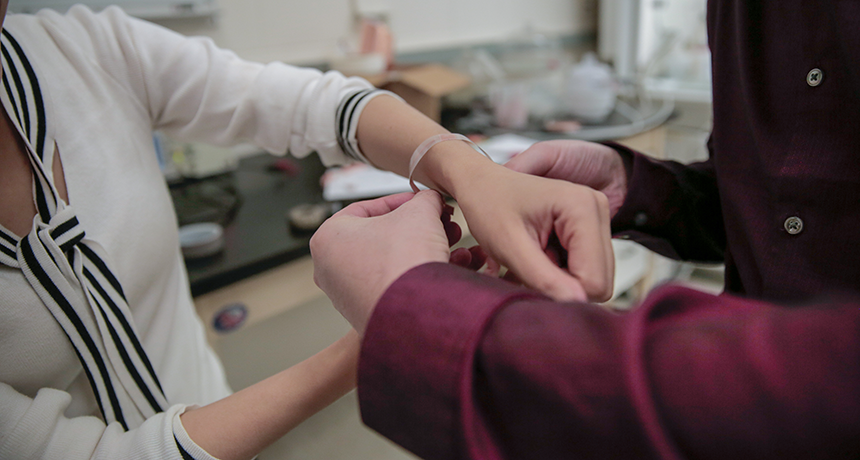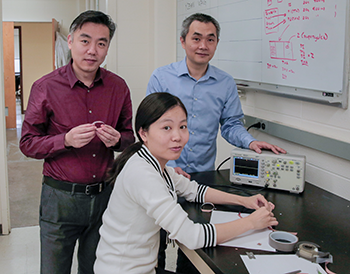This bandage uses electrical zaps to heal wounds faster
The movements of a patient’s body power this setup

A new bandage uses electrical pulses to help wounds heal faster. It’s powered by the patient’s natural body motions.
Sam Million-Weaver/Univ. of Wisconsin–Madison
By Ilima Loomis
One day, bandages could speed healing by zapping wounds with gentle bursts of electricity. They wouldn’t even need a battery pack. A patient’s own body movements would power the device. And such a system may not be that far off. Researchers have already produced a working prototype.
“We thought it might work, but we didn’t know how good it would be,” says Xudong Wang. “Then we saw the result and thought, ‘Wow! That’s really fascinating.” Wang is a materials scientist at the University of Wisconsin–Madison. He leads the group working on this new bandage.
His team has been developing a nanogenerator for many years. It uses body movements to generate electricity. These engineers were hoping to use the device to power wearable electronics. Then they realized it might be even more useful as medicine.

Scientists have known for decades that electricity can stimulate wounds to heal. For instance, electricity fosters cells on the skin’s surface to grow. This “electrotherapy” has relied on bulky devices that need a power source. That’s why it’s usually used only in hospitals for treating serious injuries.
The Wisconsin engineers have now created a bandage with small electrodes. “Our device is very simple,” Wang says. “It’s a flexible, wearable device.” Its electrodes connect to nanogenerators inside the bandage. Those nanogenerators turn movement into electricity. That power then travels through the electrodes into the skin as mild electrical pulses.
Wang’s group tested the bandage on more than 10 injured rats. As these “patients” breathed in and out, their wounds received tiny electrical shocks. Another group of injured rats served as controls. That means they received no treatment.
The wounds of rats in the control group took about two weeks to heal. Those on rats treated with the electrified bandages healed in just three days.
Wang’s team described its new findings online November 29, 2018 in the journal ACS Nano.
No pain, big gain
The new bandage not only is simple, flexible and wearable, but also gentle. Compared to the electrical stimulation delivered by hospital machines, this bandage gives a much smaller electrical pulse. That should help protect healthy tissue from being damaged by the zaps. In fact, Wang says: “Usually, you don’t even feel it.”
This is “a good first step toward an interesting and potentially promising approach to wound care,” says Tyler Ray. He says you might think of it as a “smart Band-Aid.” Ray is a mechanical engineer at the University of Hawaii at Manoa who had no role in creating the new system. He said he’d like to see the bandage tested on larger animals or people, and lots of them.
Wearable technology has been around for several years. Usually these are fairly stiff devices, like a Fitbit, Ray notes. Researchers across many fields are now working on building soft, flexible devices for people to wear on their skin.
Wang next wants to design a nanogenerator that’s even more sensitive. His goal is to build one that can generate electricity from the tiniest movements — like blood moving under your skin. That way, the bandage could be powered by something as small as someone’s pulse.
This is one in a series presenting news on technology and innovation, made possible with generous support from the Lemelson Foundation.







